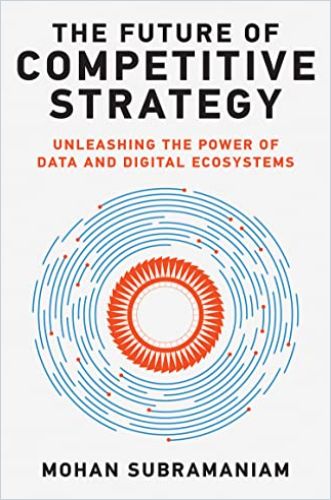“You Have to Keep Making Small Bets and Learning Quickly”

Most businesses know their survival into the future depends on their agility and ability to innovate today. Digital transformation expert David Rogers explains how mindset plus repeatable processes can help companies navigate at the speed of change.
David, you outline five steps for change in your book Digital Transformation Roadmap, beginning with articulating a shared vision, then moving through identifying strategic priorities, experimentation, managing growth at scale and growing technological solutions, talent and culture. But you emphasize a bottom-up approach, even when it comes to ideating and testing. Why is this approach more likely to succeed?
The number one challenge facing organizations today is the pace of change. Because of this, digital transformation cannot just be top down. It cannot happen with a CEO or Chief Digital Officer coming up with the big vision and strategy and then giving the execution orders to everyone else in the organization to carry out. That approach is simply not flexible and fast enough to deal with the fact that tomorrow the world will have already changed. Instead, you have to enable every level of the organization to drive transformation forward.
Give them a clear sense of where you’re going and give them the tools they need to take action. That is the only way a large organization can possibly adapt fast enough in today’s world.
How can companies give teams and departments the freedom and resources they need to experiment without the worry that they’ll be penalized for failure?
It starts with getting agreement and alignment among everyone. Everyone has to be on the same page about a few things. Where are we going? What competitive space do we hope to occupy in that future we see emerging? What impact are we seeking to have on our customers, our partners, and on the world, and what will success look like for us? If teams know what that vision is and what their strategic priorities are, and if each team has defined metrics of success so they know specifically what they are trying to achieve and how you’ll know if they’ve achieved it, then every team can begin to drive things forward. They will be able to move much more quickly and much more independently, but only if they have that in place first.
I know you emphasize not getting obsessed with tech first, but should companies train employees in AI or other relevant technologies so that they’ll have more knowledge when coming up with innovative ideas?
The skills that teams should acquire next depend very much on the problems that they are trying to solve. Let me give an example: Johnson and Johnson. A former student of mine has been leading their digital transformation on the HR side for a number of years. And one skill set they’ve been building up is around robotics. Those skills are really necessary for the medical devices division. They have not needed to build up those skills within their consumer pharmaceuticals or over-the-counter products division. The question to ask is where a digital capability is most relevant to exploration, which depends on the strategic priorities and the nature and contours of each part of your business.

Learn more about The Digital Transformation Roadmap, due out in Fall 2023.
Okay. You also emphasize defining problems first and then testing solutions through a chain of validation. What are the Four Stages of Validation?
This is a model I developed to help organizations shift to a process of rapid experimentation. It’s informed by important methodologies like design thinking, agile software development, lean startup and product development. They all taught us that new ideas need to be iteratively tested in the market. We need to get good at moving fast, taking on low costs and low risk to learn really early about the ideas we are considering before we make huge commitments of resources. But when established businesses first get this – they shift their mindset and they want to start experimenting – there’s a really common problem.
They all ask me, where do we start? Do I test features first? Do I run tests on what the price point should be? Do I try to figure out the market size before I do anything else?
There are so many questions and people don’t know where to begin. So, the Four Stages of Validation – to evaluate Problem, Solution, Product, Business – is a model to just organize and sequence this process for any innovation you might be pursuing.
Why is answering just one question at each stage so important to success?
The stages are based around four essential questions that must be answered about any new innovation, any new growth venture. First, what problem are we trying to solve? Second, what solution will actually interest the customer or the user? Third, what’s the product form of that solution that we can actually deliver, and that the customer will use in their real life or work? Very often customers will ask for something or say, “that sounds great” and then when you give it to them, they try it once or twice and then drop it like a hot potato. And lastly, the fourth question is, what business model can we use to capture value, whether it’s revenue or it’s reducing costs or reducing business risk? What is it we can do to create a path to profit from this idea? And if there is one, is the upside big enough that it really matters for our own enterprise? You have to answer all four of those questions before you are ready to take any innovation to market at scale. But you’ve got to ask them in the right order.
You have to start them in the right order, but you stack them too, right? And the status is constantly changing according to the feedback and the data that you get as you deploy each stage.
Yes, to be clear, these stages are overlapping. You don’t answer the first question and then you’re done and move on to stage two. You keep learning. You keep going back and revalidating – what problems are you solving and who, really, is the optimal customer who needs that problem solved? Once you start testing and validating which solution really achieves product-market fit to draw that customer demand, you don’t stop that process.
You will always need to keep revalidating that as you build the product. You don’t do one version and you’re done.
You’re going to launch with the skinniest, leanest version of what I call a functional MVP (minimal viable product). It’s no longer just an illustration of what you might build. It actually has to do something for the customer, but it’s got to start with as little to it as possible. So, you keep that process going over and over and then you start business model validation: What’s the revenue model? Who do you charge? What’s the price point? Do you bundle? What are the costs? What’s your customer lifetime value? What are the unit economics? These are ongoing questions! If you are so lucky as to succeed and you’re taking this to market, at every stage, as you move from those early adopters to more customers, you have to relearn all these answers, all these questions, all over again. It’s an ongoing process. As my friend Bob Dorf says, “Validation only ends when you sell the furniture for pennies or the business for billions.”
I think that’s also a wonderful way of answering the question, “how do you keep up with the pace of change?” You keep changing, but systematically rather than reacting.
The learning has to be something that you are doing proactively, that you are constantly iterating.
We’ve talked about how companies can keep pace and how you can have some sort of a discipline to make sure you’re not executing on an outdated roadmap, by constantly revisiting it and reevaluating based on data and feedback, but let’s talk about innovation structures. What are some of the best practices for keeping up to speed, and how can companies coordinate their efforts internally, including best governance structures?
If organizations are going to drive this kind of change and experimentation at scale, it’s not enough to have a team here or a team there working on some new ideas. You need this happening across the whole organization.
Whenever you are trying to go after opportunities that have either significant uncertainty, or that are outside of your core business, you can’t rely on your existing governance.
Instead, you’re going to need a few things: First, you need small, empowered, multifunctional teams. They’re the ones who are going to be able to move fast and do this kind of iterative validation. Second, you need to establish supervisory boards who are senior enough to have some clout and influence and wide-ranging perspectives, but also have the time to advise these teams and bring in outside points of view. Lastly, you need to set up repeatable processes for three things. One is a process to greenlight new ideas for that first round of testing. Then you need a process for iterative funding. Not an annual budget process, but a much shorter, more rapid and flexible process. Lastly, you need a process for smart shutdowns where you are continually taking most of the ideas you greenlit out of production and say, “Well, we learned some interesting things here. We don’t have a strong enough signal to keep going forward. Let’s free up the resources, put those people onto another opportunity, another problem to solve, and see what we can do there.”
So, you take the approach that venture capitalists take, illustrated in your book, when the uncertainty is the highest, small teams pitch for small investments from their governance board and they keep pitching along the way as they reach milestones.
Yes, that’s central to this process of iterative funding. When you’re starting in those first rounds, you actually want to greenlight as many ideas as possible with as few resources as possible for each of them. It’s like a seed round or an angel investor round where you put in just a little bit of money, not because you think this idea will work, but because you think there’s an outside chance that just maybe it might work. That’s how investors think at that very first stage. But the investment strategy shifts as VC’s go on to later rounds. The same thing happens with governing innovation boards and companies; each time the team comes back on this venture to ask for the next round, they have to show additional market validation.
Then, if the team is reducing the uncertainty of the idea, the investment should not go up 10% or incrementally. It should go up exponentially, just like investing in a new startup. That’s how you’re going to get to scale on the ideas that really will have an impact.
There are many promising ideas out there, but they aren’t all worth doing, which is why the validation process is so important.
We used to think that the key to innovation was great ideas, and that turned out to be wrong. The truth is, there are lots of great ideas, but most of them will not work in the real world of your customers, your market, your competitors, your regulators, at least not at this precise moment in time. Sometimes an idea that doesn’t work will come back in a year or two or five years later. That’s why you have to keep making these small bets and learning very quickly and being ready to shut things down and shift your resources to the next idea that you’ve got in your pocket.
And you look at that as an investment in learning, which also changes how people think about failure in their culture, right?
Exactly. If you are shutting an idea down based on validation and testing in the early stages, here is what you didn’t do: You didn’t spend a year developing a business case and then throw a whole lot of money at the idea because a top leader signed off on it and you want to show them that they’re important. Instead, if you greenlit the team after one meeting and you gave them 90 days or maybe they got to 180 days and you’ve learned enough to shut it down, what you have not done is spent money on an innovation that failed. What you have done is you’ve spent money to learn critical business knowledge for the company about where you should and should not invest.
Let me ask you about a Chief Digital or Innovation Officer. Should companies consider hiring for this role?
It can be a good idea to have a Chief Digital Officer or Chief Innovation Officer at the start. Typically, in companies of some size, the CEO is too busy to oversee in a day-to-day fashion all the things that need to be starting to take action as part of a digital transformation. The role of the Chief Digital Officer is to work closely with the CEO on clarifying that vision of where you’re going and why. But then the CDO is the one out there overseeing, coordinating, identifying opportunities and where resources should be put. It is not a technology role. This person should be working closely with your IT division, with your HR leadership, and with your strategy team if you have one.
The key skills of the Chief Digital Officer are people skills, the ability to inspire and persuade and listen and figure out what people need to do, the kind of work that you’re hoping they will do. It’s not about giving a lot of marching orders.
When this works, what I see is, over time, the organizational change you are hoping for starts to get established in the different business units and in processes and teams and governance boards and so forth. At that point, the Chief Digital Officer starts to fade away. If they’ve done a good job, they typically move to some other business role within the company because they have a lot of value and skill, but they can now get more involved in really driving some of this change within one or more business units.
How can companies build more agile connections? What are the connecting positions between the everyday desk worker and the IT-related workforce?
Rather than trying to figure out how do we get the business workers to communicate better with the IT workers, we need to put them together. This is the essence of the small, multifunctional team. You need to break through silos and create teams who have a mixed skill set, a mixed set of perspectives. Those are the teams who are going to be able to move faster and bring new ideas forward much more effectively when they are empowered and given the resources and the management and governance to do their best work.
That makes good sense. How can a company develop a bias for risk-taking?
That’s a great example of a shift in culture that needs to happen in many organizations to succeed in the digital era: to shift from a bias towards caution and CYA, towards a bias for action and risk-taking. If you want that to happen, first, you need to implement the kind of repeatable processes we’ve talked about. Teams need to be trained in and know how to follow the Four Stages of Validation. Resources need to be given out, not in annual budgeting, but with iterative funding processes. You need to have growth boards that can oversee these teams and greenlight ideas and fund them and shut them down. But it is also about a broader, more intangible culture.
Leaders play three important roles in shaping the culture that they want: First, they define it.
Leaders must figure out what is that cultural behavior that you need to instill and lean into and develop more of. Second, they need to communicate that culture to others. That’s a huge job of leadership, continually communicating, communicating, communicating — and in ways that really resonate. Third, leaders have to constantly enable others to live up to that culture. It’s not about giving orders. It’s about seeing the roadblocks, what is currently keeping people from behaving in the way that you want. This may be incentives, it may be resource allocation, it may be metrics. The key is finding out what is misaligned with your desired culture and removing those roadblocks, so people can really behave in the way that you want them to.
About the Author:
David Rogers is the author of the bestseller The Digital Transformation Playbook and the upcoming Digital Transformation Roadmap. He has worked with Fortune 500 executives as a business transformation consultant. He teaches digital business strategy at Columbia Business School. You can contact him through his website DavidRogers.Digital.
Read more on innovation and driving change in your organization:







